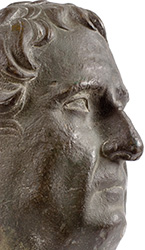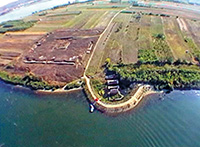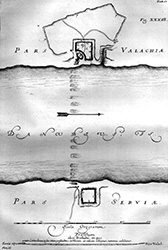Traces
SERBIAN ARCHAEOLOGY IN 150 STORIES: COMPLEX OF TRAJAN’S BRIDGE NEAR MODERN KLADOVO
Great Architectural Achievement
It was built within the preparations for conquering Dacia, in only two years, which is amazing even from the perspective of modern technology. Built on twenty pillars, it was 1,100 meters long, and about 45 meters high. It comprised a single unit with two fortifications, Pontes on the right and Drobet on the left bank. Emperor Trajan was very proud of this building, and the image of the bridge found its way to coins and on the famous Trajan’s column in Rome. It will forever remain a mystery whether the emperor’s heir Hadrian really had to destroy this monumental and famous building
By: Vojislav Filipović
Photographs: Museum in Kladovo, National Museum
in Belgrade, Archive of ”National Review”
 Trajan’s Bridge on the Danube is considered to be one of the most significant and monumental parts of Roman architecture. It was situated five kilometers from the modern Kladovo, near the village of Kostol, and it used to connect former Roman provinces of that time, Upper Moesia and Dacia. It was build based on the idea of Emperor Trajan (98–117), within bigger construction preparations for the so-called Dacia Wars and annexation of that province to the increasingly powerful Roman Empire. Then, based on Trajan’s order, construction of the Đerdap road was completed, and the line of fortifications along this part of the border was strengthened or erected. Trajan’s Bridge on the Danube is considered to be one of the most significant and monumental parts of Roman architecture. It was situated five kilometers from the modern Kladovo, near the village of Kostol, and it used to connect former Roman provinces of that time, Upper Moesia and Dacia. It was build based on the idea of Emperor Trajan (98–117), within bigger construction preparations for the so-called Dacia Wars and annexation of that province to the increasingly powerful Roman Empire. Then, based on Trajan’s order, construction of the Đerdap road was completed, and the line of fortifications along this part of the border was strengthened or erected.
Actually, Trajan’s Bridge as a whole represents a complex of two fortifications, on the left and right bank of the Danube – Pontes in Serbia and Drobet in Romania – and the monumental bridge with access platforms and a road. It was built in the eve of the Second Dacia War, in record time of only two years (103–105), and the construction was entrusted to the court architect Apollodorus of Damascus, who had already built several other bridges around the empire under Trajan’s reign.
The place for construction of the bridge was selected because of natural characteristics of the Danube on this part of its flow. On that spot the river was relatively shallow, with sandy bottom and peaceful flow. And the terrain in the hinterland of what is today Kladovo was also sandy, and Apollodorus used this advantage and dug a canal diverting the course of the Danube, so the construction of at least one half of the pillars was carried out on a relatively dry basis.
 The architect was placing wooden pillars into riverbed, placing the load-bearing pillars on them, the interior of which was filled with rock and mortar. Ancient writers say, and archaeological explorations have confirmed, that the bridge was about 1,100 meters long and built on 20 pillars. Thickness of the pillars was impressive 19 meters and they all had wedge-shaped extensions made of stone blocks perpendicular to the flow of the Danube, in order to reduce pressure of the water current on the bridge. Pillars of the bridge were probably connected with wooden vaults, and its width was 14.5 meters. The only data about the height of the bridge comes from the quill of Dion Cassius, Roman consul and historian, who mentions height of as much as 150 Roman feet, about 45–46 meters. The bridge was accessed near the mentioned fortifications. There are four pillars registered near Pontes, which represented an access platform. The last and the highest pillar, which today stands on the very bank, represented an entrance portal to the bridge and, in accordance with visual imagery of that time, it resembled a triumphal arc with statues on top. The architect was placing wooden pillars into riverbed, placing the load-bearing pillars on them, the interior of which was filled with rock and mortar. Ancient writers say, and archaeological explorations have confirmed, that the bridge was about 1,100 meters long and built on 20 pillars. Thickness of the pillars was impressive 19 meters and they all had wedge-shaped extensions made of stone blocks perpendicular to the flow of the Danube, in order to reduce pressure of the water current on the bridge. Pillars of the bridge were probably connected with wooden vaults, and its width was 14.5 meters. The only data about the height of the bridge comes from the quill of Dion Cassius, Roman consul and historian, who mentions height of as much as 150 Roman feet, about 45–46 meters. The bridge was accessed near the mentioned fortifications. There are four pillars registered near Pontes, which represented an access platform. The last and the highest pillar, which today stands on the very bank, represented an entrance portal to the bridge and, in accordance with visual imagery of that time, it resembled a triumphal arc with statues on top.
INSPIRATION THROUGH CENTURIES
 For Trajan, the bridge on the Danube represented an extraordinary personal, but also state enterprise, so it was often used on money as a motif of imperial propaganda. Therefore, after the end of construction in 105, Trajan issued a series of sestertii with image of the bridge on the backside of the coin. This image clearly shows an arc bridge with entrance gates with statues on top, while a ship is sailing under the bridge. Another image of the bridge on the Danube can be seen on the triumphal Trajan’s column, with scenes from Dacia Wars. On the frieze there is a clear image of the emperor making an offering over the altar during the bridge opening ceremony, and the bridge is faithfully presented in the background. For Trajan, the bridge on the Danube represented an extraordinary personal, but also state enterprise, so it was often used on money as a motif of imperial propaganda. Therefore, after the end of construction in 105, Trajan issued a series of sestertii with image of the bridge on the backside of the coin. This image clearly shows an arc bridge with entrance gates with statues on top, while a ship is sailing under the bridge. Another image of the bridge on the Danube can be seen on the triumphal Trajan’s column, with scenes from Dacia Wars. On the frieze there is a clear image of the emperor making an offering over the altar during the bridge opening ceremony, and the bridge is faithfully presented in the background.
 Unfortunately, significant financial resources, new architectural solutions, as well as sweat of the builders invested in this enterprise did not finally leave in the world cultural heritage one of the most beautiful examples of historical monumental and innovative architecture. It was already Trajan’s heir Hadrian, who ordered the wooden structure of the bridge to be burned down, apparently to prevent penetration of barbarians over the Danube. In the early 3rd century, the said historian Dion Cassius says that the bridge caused envy of the new emperor, and its architect, Apollodorus, was exiled from the capital and was soon killed. Cassius also mentions the height of the bridge and that the pillars were impressive, but it is not certain whether the bridge was functional at that time. Procopius, a 16th century Byzantine writer, testifies that the pillars and the bridge were in ruins. Unfortunately, significant financial resources, new architectural solutions, as well as sweat of the builders invested in this enterprise did not finally leave in the world cultural heritage one of the most beautiful examples of historical monumental and innovative architecture. It was already Trajan’s heir Hadrian, who ordered the wooden structure of the bridge to be burned down, apparently to prevent penetration of barbarians over the Danube. In the early 3rd century, the said historian Dion Cassius says that the bridge caused envy of the new emperor, and its architect, Apollodorus, was exiled from the capital and was soon killed. Cassius also mentions the height of the bridge and that the pillars were impressive, but it is not certain whether the bridge was functional at that time. Procopius, a 16th century Byzantine writer, testifies that the pillars and the bridge were in ruins.
 Archaeological explorations confirmed that in the Middle Ages both fortifications, Pontes and Drobeta, were inhabited by military troops. At that time, remains of the bridge were probably used for easier maneuvering of ships, since certain armies were led over the river exactly on that spot. Old records also say that Turkish sultan Suleiman the Magnificent (1520–1566) was impressed with the remains of the bridge, and was thinking about building a similar structure near Vienna. Archaeological explorations confirmed that in the Middle Ages both fortifications, Pontes and Drobeta, were inhabited by military troops. At that time, remains of the bridge were probably used for easier maneuvering of ships, since certain armies were led over the river exactly on that spot. Old records also say that Turkish sultan Suleiman the Magnificent (1520–1566) was impressed with the remains of the bridge, and was thinking about building a similar structure near Vienna.
One of the first explorers who left a detailed description and graphical presentations of the remains of the bridge was Italian count Marsiglii, a talented military engineer, who was, after the Peace of Karlovac, entrusted with a task to draw new border between the Habsburg Monarchy and Ottoman Empire. On this occasion, Marsiglii documented the remains of both fortifications, access roads and 15 pilars of the bridge in the Danube riverbed. He mentioned that Emperor Leopold I used Trajan’s Bridge in 1689 and by means of a simple over-structure he led his army over the Danube further toward Vidin.
In 1906, the International Commission for the Danube decided to destroy two pillars of the bridge that hindered navigation on the river, and in 1932, remains of only 16 of them were confirmed. More recent underwater archaeological explorations carried out in mid 1980’s, registered remains of only 12 pillars.
THREE EXTRAORDINARY FINDINGS
 Pontes is also the site where two extraordinary findings of Roman origin were found, which bear witness to the significance of this bridge. On the first place, it is a bronze portrait discovered in 1850 in the riverbed near the load-bearing pillars. A man’s head cast in bronze, with traces of gold-plating, has characteristics of Roman realism of the first century and it is reasonably to believe that this was a portrait of Trajan’s father. Pontes is also the site where two extraordinary findings of Roman origin were found, which bear witness to the significance of this bridge. On the first place, it is a bronze portrait discovered in 1850 in the riverbed near the load-bearing pillars. A man’s head cast in bronze, with traces of gold-plating, has characteristics of Roman realism of the first century and it is reasonably to believe that this was a portrait of Trajan’s father.
The second finding is an iron ceremonial helmet with a mask, discovered in 1854 near the bridge. It is a mask with openings for eyes, nose and mouth, attached to the helmet that is made/decorated in the shape of hair. The finding could belong to the period when the bridge was functional and is probably a product of Italic workshops. It represented a par of ceremonial equipment of high-ranking officers of the Roman army and it is unparalleled in Roman art.
Finally, we should also mention the medieval bronze pitcher discovered in the pantry-hiding room in the Pontes fortification. It is an exceptional example of a vessel made on the Christian East that was used in religious service, which can be seen from the inscription in Greek toward the top of the vessel: The voice of the Lord over the water will rise again. In addition to the inscription, the pitcher is decorated with carved and punctuated friezes with floral motifs, while the handle is decorated with head of a panther, bird and ram. The pantry is buried probably during 11th century, when serious battles for power are being waged in these territories between Byzantine, Bulgaria and individual Slavic tribes. <
***
Feats of Apollodorus of Damascus
After the bridge n the Danube, Trajan entrusted Apollodorus with construction of other most significant architectural feats in the empire, such as imperial therme, Trajan’s forum and monumental Trajan’s Column. During the reign of Emperor Hadrian (117–138), Trajan’s heir on the throne, Apollodorus restored the Pantheon from the foundation, which has been, until today, one of the few preserved original buildings from the Roman period.
***
Edges of the canal
Parts of the canal used by Apollodorus to divert the Danube still exist today, in the form of a few lakes. They begin near the Fetislam fortification, to the west from Kladovo, and end near the Danube island of Šimijan.
***
Record
Feliks Kanic, tireless explorer of Balkan antiquity, says that in January 1858, because of extremely low water level, all 20 pillars could have been seen. He also mentions another interesting fact: in 1898, Romanian and Serbian kings Karol II and Aleksandar Obrenović agreed on reconstruction of Trajan’s Bridge, but further preparations and estimates showed that it would not be a good structural solution for railway traffic, and they soon abandoned this idea.
|
